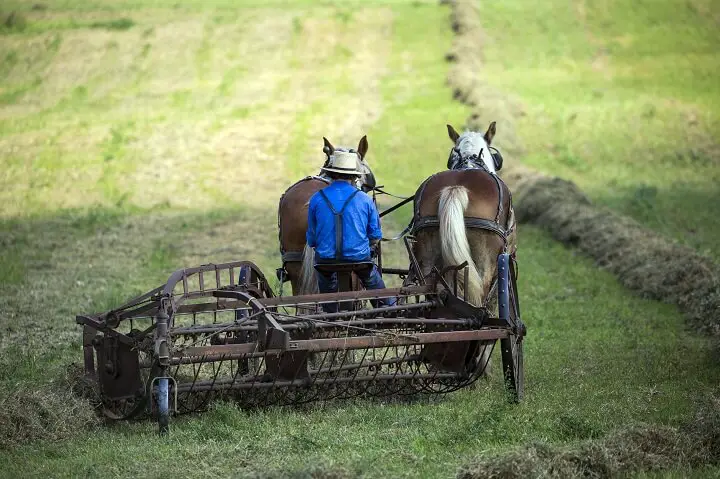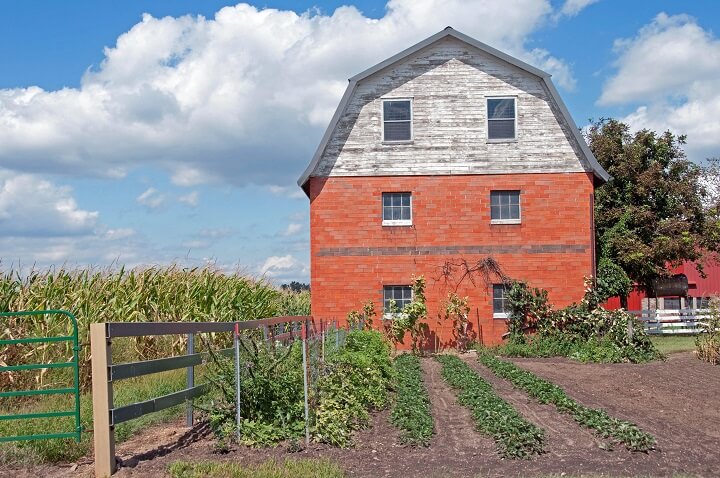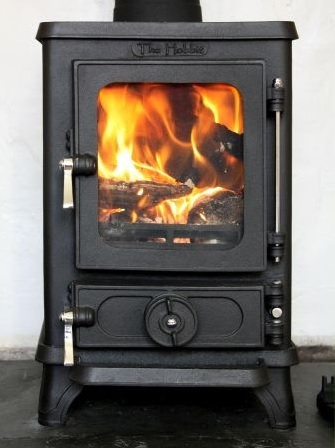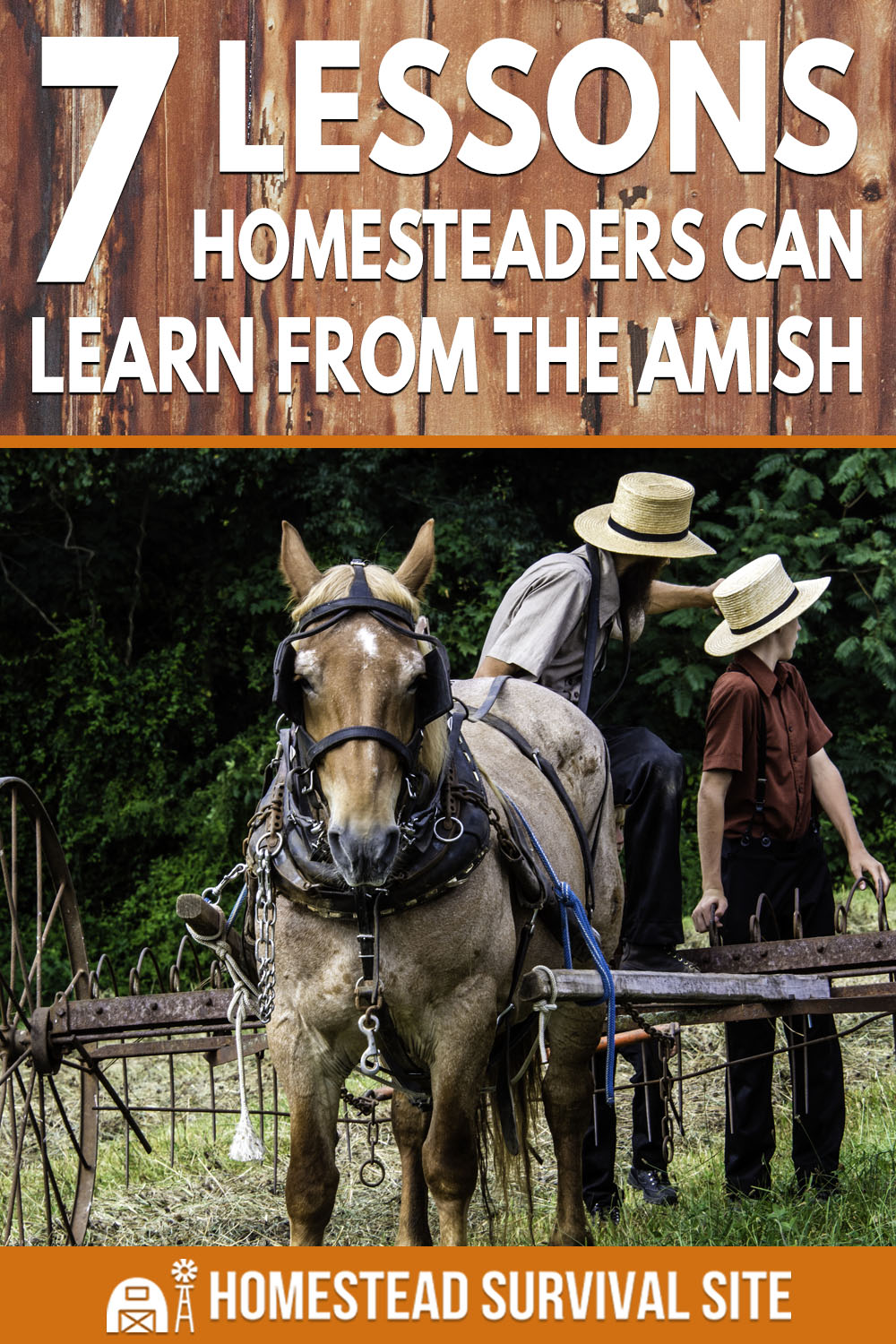Estimated reading time: 9 minutes
Survival homesteaders can learn a lot from the Amish. In our high-tech era of smartphones, movie live streaming, and Alexa, these plain folks are still managing sustainable off-grid homesteads and thriving businesses without any of the luxuries of the modern world.
There are approximately 300,000 Amish folks living around the country. Exactly how each Amish family lives and works varies based upon the cultural standards in their individual communities. A visit to an Amish community or farm is always quite illuminating – but rarely the same experience twice.
The Amish farrier in my rural area once referenced his peers who live about 15 miles away on the far edge of our country who operate a highly successful greenhouse business. Ezra gave a head shake when asked a question about the other clan, noting he really doesn’t associate with them because they are “too modern.” The greenhouse Amish folks allow the women and children to ride bicycles.
Regardless of the slight differences in cultural standards, all Amish families in America live off-grid. None of them allow electricity in their homes. If an Amish family purchases a modern home, they either tear the electricity clear out or have the service disconnected and stubbed off in the walls. Some Amish have indoor bathrooms, others do not.
In Ohio, where the second largest population of American Amish live (Pennsylvania boasts the most) some communities now use solar and/or gas-powered generators.
Want to save this post for later? Don't Forget to Pin It On Pinterest!
Top 7 Lessons Homesteaders Can Learn From The Amish
1. Mindset
This is the first and arguably the most important lesson any homesteader—regardless of where they live or how much land they own—can learn from the Amish.
Homesteading has become quite a popular lifestyle choice, even for folks who live in an urban environment. That’s a very good thing. The more self-reliant folks living in America the better – especially from a survival aspect.
But you can't simply flip a switch, start growing your own groceries and start raising a few laying hens and suddenly be equipped with the proper mindset to homestead.
The Amish live simply, to say the least. While you may not go to the same off-grid extremes on your own homestead, you must adapt your way of thinking about what daily life will look like on a regular basis.

Looking at homesteading like an accessory to your current lifestyle will not only negate all the self-reliance and survival benefits it offers, but doom your new homesteading dream to failure.
• Home Life
An Amish person’s life, regardless of sex or age, is centered around work. You don't get to lounge on the couch just because you're sick, there's two feet of snow outside, it is a holiday, or you're tired from being up all night binge-watching something on Netflix.
There is a lot of joy in the Amish day, with the bulk of it stemming from enjoying the simple and natural pleasures in life and from the sense of a job well done, not going out to dinner, to the mall, or playing with hand-held tech gadgets.
Home decor takes a massive back seat to functionality. It takes a copious amount of workspace to preserve food, cook food from scratch, sew clothing for the family, and start seeds for the coming year’s crop.
• Work Life
The Amish live and work either in their home or a short distance (walking or horse-drawn buggy ride) from it. While working from home is ideal for homesteading, it is not a requirement for success.
But if you spend an extensive time away from the homestead for either work or pleasure, you won't have time to work the land properly in order to feet your family from what you grow and raise. You also won't have time to chop, split, and stack the firewood you need to heat your home, among many other things.
A strong work ethic is instilled, demanded, and highly praised from a very young age in Amish culture. There is a direct line between doing your assigned tasks well and keeping the family warm, fed, and clothed.
• Family Life
Not only are families large in Amish communities, extended loved ones and multi-generations often live together on a single farm. This style of communal living not only provides extra hands for farm and business chores, but also helps build strong relationships, family history, skills, and bonds everyone both together and to the land.
• Spending Habits
Frugality is at the cornerstone of Amish life. You learn to make do with what you have, find ways to repurpose items others would consider junk, and make or repair something you need on your own instead of running out to a store to buy it. Money is saved rather than spend and filtered back into the farm and the family.
2. Food Preservation
In an Amish household, you will find “canned” food but it will not be housed in aluminum containers with a vibrant label. The Amish are avid home water bath and pressure canners, meat smokers, meat salters, herb dryers, solar dehydrators, and picklers.
The more ways you know how to safely preserve your food, the more meat, vegetables, fruits, and herbs you can stockpile for pennies on the dollar compared to the price of purchasing the same items from a grocery store.
3. Gardening
The Amish garden a lot like our pioneering ancestors did. They make excellent use of every single inch of space they possess—even if they live on a large acreage farm—while wisely using natural resources. The Amish cultivate their own rich compost instead of buying quality soil to start crops, put in winter cover crops, and cultivate fall gardens – substantially adding to the harvesting and food preservation workload and yield throughout the year.

Most Amish folks could be considered master gardeners not just for their green thumb but also the pains they take with their composting, plant disease prevention and curing, as well as preventing and quickly identifying the presence of destructive insects.
4. Livestock Husbandry
An Amish farmer often functions as a de facto or layperson vet on their farm. Years of working with the animals coupled with the generations of shared knowledge in the farming family allow the Amish to develop excellent breeding livestock programs.
They are able to deal with gestation and delivery emergencies, identify colic, lameness, bloat, and a series of other potentially deadly medical conditions quickly and take immediate steps to treat them, often with natural herbal treatments they make themselves.
5. Fence Construction
A homestead will only be as productive as its weakest section of fence. If the garden and barnyard areas are not fenced properly, the growing groceries will be consumed by rabbits, possums, and deer and never make it to your dinner table. Predators lurking in the woods, possibly just a few feet away from the barn and chicken coop, can wipe out an entire flock or even a goatherd in a single night if they are not protected appropriately by a solid and well-constructed fence with a gate and 2-step locks.
Building such a fence might not seem like rocket science. But, any newbie homesteader who did not take the time to learn more about fence construction and materials and instead used chicken wire on their poultry run can likely detail the carnage they had to clean up because of this dire mistake.
6. Alternative Power
Reducing the homestead’s reliance upon traditional power sources is typically a goal for all survival homesteaders. It is a misconception made by many that the Amish merely light their homes with candles and go to bed at dark. The Amish use hanging lights and have table lamps that are powered by alternative off-grid fuel.
As noted above, the Amish have mastered the use of solar polar—even in hilly Midwest regions—to power not just a low-tech home, but substantial workshop factories and stores.
In an Amish home, you might also find a propane-powered refrigerator and a pioneering style wood cookstove. It takes a minute or two to figure out how to regulate the heat on a wood cookstove, but once you master that skill, you have a multi-purpose heat generator, stove, and oven.

Having a fireplace in your home will provide some heat, but the Amish use wood stoves to heat large two-story homes (plus basements) as well as a means of creating an off-grid hot water tank.
Far too many homesteaders shy away from using wood stoves on their homesteads because they believe the units are unaffordable, too difficult to install, too large for their small space, and/or too heavy to place in a basement or second floor. The wise Amish use of one or more wood stoves to make a home entirely electric free solidly debunks those concerns.
A “hobbit” style cast iron stove like the Tiny Salamander Stove costs less than $900, weighs little more than 100 pounds and has a 13.6k heat output.
7. Farm Equipment
Survival homesteaders should spend just a few hours watching an Amish farmer do all of the same chores on his land as the prepper does on his large acreage retreat – he or she would be in awe.
It may surprise modern homesteaders to know that horse-drawn farm equipment is still being manufactured and readily used on Amish farms and off-grid homesteads around the country. The weeklong Mount Hope Auction in Ohio’s Amish country attracts homesteaders and preppers from across America to buy this type of EMP-proof, horse-powered, and easy-to-work-on equipment, as well as a host of other long-forgotten manual tools, each year.
The Amish have a multitude of survival homesteading lessons we modern-day homesteaders would be wiser and more self-reliant for learning. Survival homesteaders are focused on preparing for a day when society is in chaos, the light switch will not yield power, and the kitchen faucets have run dry.
The Amish are living this type of lifestyle day in and day out right now – and have been doing so for thousands of years. You really can’t find a better prepper homesteading mentor than that.
Like this post? Don't Forget to Pin It On Pinterest!












I am always looking to have a more sustainable lifestyle. And never heard what the amish do in bad weather to keep things going.
I guess they survive off of things they have stockpiled until things clear up.
Each and every one of us looks for a decent lifestyle. It is not that we only learn from the particular thing or from the particular person. We can learn from many people and in many ways. Just like the Amish. They offer same information here Realcountry.co.nz one must check them also.